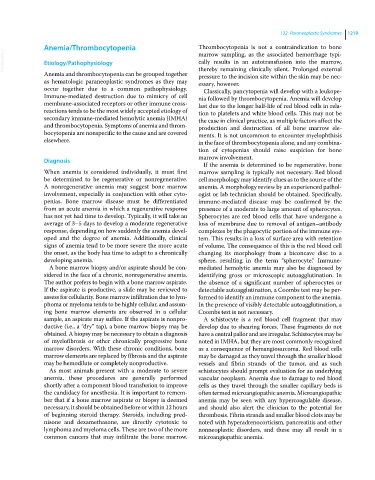Page 1281 - Clinical Small Animal Internal Medicine
P. 1281
132 Paraneoplastic Syndromes 1219
Anemia/Thrombocytopenia Thrombocytopenia is not a contraindication to bone
VetBooks.ir Etiology/Pathophysiology marrow sampling, as the associated hemorrhage typi-
cally results in an autotransfusion into the marrow,
Anemia and thrombocytopenia can be grouped together thereby remaining clinically silent. Prolonged external
pressure to the incision site within the skin may be nec-
as hematologic paraneoplastic syndromes as they may essary, however.
occur together due to a common pathophysiology. Classically, pancytopenia will develop with a leukope-
Immune‐mediated destruction due to mimicry of cell nia followed by thrombocytopenia. Anemia will develop
membrane‐associated receptors or other immune cross‐ last due to the longer half‐life of red blood cells in rela-
reactions tends to be the most widely accepted etiology of tion to platelets and white blood cells. This may not be
secondary immune‐mediated hemolytic anemia (IMHA) the case in clinical practice, as multiple factors affect the
and thrombocytopenia. Symptoms of anemia and throm- production and destruction of all bone marrow ele-
bocytopenia are nonspecific to the cause and are covered ments. It is not uncommon to encounter myelophthisis
elsewhere. in the face of thrombocytopenia alone, and any combina-
tion of cytopenias should raise suspicion for bone
marrow involvement.
Diagnosis
If the anemia is determined to be regenerative, bone
When anemia is considered individually, it must first marrow sampling is typically not necessary. Red blood
be determined to be regenerative or nonregenerative. cell morphology may identify clues as to the source of the
A nonregenerative anemia may suggest bone marrow anemia. A morphology review by an experienced pathol-
involvement, especially in conjunction with other cyto- ogist or lab technician should be obtained. Specifically,
penias. Bone marrow disease must be differentiated immune‐mediated disease may be confirmed by the
from an acute anemia in which a regenerative response presence of a moderate to large amount of spherocytes.
has not yet had time to develop. Typically, it will take an Spherocytes are red blood cells that have undergone a
average of 3–5 days to develop a moderate regenerative loss of membrane due to removal of antigen–antibody
response, depending on how suddenly the anemia devel- complexes by the phagocytic portion of the immune sys-
oped and the degree of anemia. Additionally, clinical tem. This results in a loss of surface area with retention
signs of anemia tend to be more severe the more acute of volume. The consequence of this is the red blood cell
the onset, as the body has time to adapt to a chronically changing its morphology from a biconcave disc to a
developing anemia. sphere, resulting in the term “spherocyte.” Immune‐
A bone marrow biopsy and/or aspirate should be con- mediated hemolytic anemia may also be diagnosed by
sidered in the face of a chronic, nonregenerative anemia. identifying gross or microscopic autoagglutination. In
The author prefers to begin with a bone marrow aspirate. the absence of a significant number of spherocytes or
If the aspirate is productive, a slide may be reviewed to detectable autoagglutination, a Coombs test may be per-
assess for cellularity. Bone marrow infiltration due to lym- formed to identify an immune component to the anemia.
phoma or myeloma tends to be highly cellular, and assum- In the presence of visibly detectable autoagglutination, a
ing bone marrow elements are observed in a cellular Coombs test is not necessary.
sample, an aspirate may suffice. If the aspirate is nonpro- A schistocyte is a red blood cell fragment that may
ductive (i.e., a “dry” tap), a bone marrow biopsy may be develop due to shearing forces. These fragments do not
obtained. A biopsy may be necessary to obtain a diagnosis have a central pallor and are irregular. Schistocytes may be
of myelofibrosis or other chronically progressive bone noted in IMHA, but they are most commonly recognized
marrow disorders. With these chronic conditions, bone as a consequence of hemangiosarcoma. Red blood cells
marrow elements are replaced by fibrosis and the aspirate may be damaged as they travel through the smaller blood
may be hemodilute or completely nonproductive. vessels and fibrin strands of the tumor, and as such
As most animals present with a moderate to severe schistocytes should prompt evaluation for an underlying
anemia, these procedures are generally performed vascular neoplasm. Anemia due to damage to red blood
shortly after a component blood transfusion to improve cells as they travel through the smaller capillary beds is
the candidacy for anesthesia. It is important to remem- often termed microangiopathic anemia. Microangiopathic
ber that if a bone marrow aspirate or biopsy is deemed anemia may be seen with any hypercoagulable disease,
necessary, it should be obtained before or within 12 hours and should also alert the clinician to the potential for
of beginning steroid therapy. Steroids, including pred- thrombosis. Fibrin strands and smaller blood clots may be
nisone and dexamethasone, are directly cytotoxic to noted with hyperadrenocorticism, pancreatitis and other
lymphoma and myeloma cells. These are two of the more nonneoplastic disorders, and these may all result in a
common cancers that may infiltrate the bone marrow. microangiopathic anemia.

